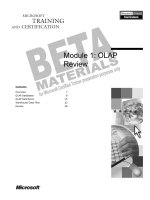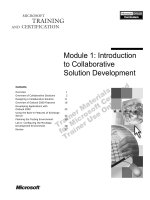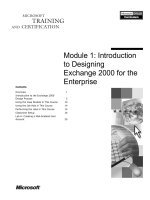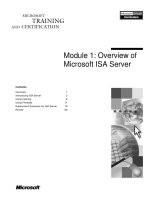Module 1: OLAP Review
Bạn đang xem bản rút gọn của tài liệu. Xem và tải ngay bản đầy đủ của tài liệu tại đây (943.07 KB, 28 trang )
Contents
Overview 7
OLAP Databases 8
OLAP Definitions 15
Warehouse Data Flow 22
Review 28
Module 1: OLAP
Review
BETA MATERIALS FOR MICROSOFT CERTIFIED TRAINER PREPARATION PURPOSES ONLY
Information in this document is subject to change without notice. The names of companies,
products, people, characters, and/or data mentioned herein are fictitious and are in no way intended
to represent any real individual, company, product, or event, unless otherwise noted. Complying
with all applicable copyright laws is the responsibility of the user. No part of this document may
be reproduced or transmitted in any form or by any means, electronic or mechanical, for any
purpose, without the express written permission of Microsoft Corporation. If, however, your only
means of access is electronic, permission to print one copy is hereby granted.
Microsoft may have patents, patent applications, trademarks, copyrights, or other intellectual
property rights covering subject matter in this document. Except as expressly provided in any
written license agreement from Microsoft, the furnishing of this document does not give you any
license to these patents, trademarks, copyrights, or other intellectual property.
2000 Microsoft Corporation. All rights reserved.
Microsoft, BackOffice, MS-DOS, Windows, Windows NT, <plus other appropriate product
names or titles. Replace this example list with list of trademarks provided by copy editor.
Microsoft is listed first, followed by all other Microsoft trademarks in alphabetical order. > are
either registered trademarks or trademarks of Microsoft Corporation in the U.S.A. and/or other
countries.
Content developed by OLAP Train, Inc. for Microsoft Corporation and distributed under license.
The names of companies, products, people, characters, and/or data mentioned herein are fictitious
and are in no way intended to represent any real individual, company, product, or event, unless
otherwise noted.
Other product and company names mentioned herein may be the trademarks of their respective
owners.
Module 1: OLAP Review iii
BETA MATERIALS FOR MICROSOFT CERTIFIED TRAINER PREPARATION PURPOSES ONLY
Instructor Notes
A prerequisite for this course is that students have taken course 2074A,
Designing and Implementing OLAP Solutions with Microsoft
®
SQL Server
™
2000, or have equivalent experience.
This module is a quick review of essential online analytical processing (OLAP)
concepts and terminology that students should already be familiar with if they
meet the prerequisite. For students who have not met the prerequisite, the
information in this module is essential for completing the balance of course
2093 Implementing Business Solutions with MDX in Microsoft SQL Server
2000.
After completing this module, students will be able to:
!
Understand the basic elements of OLAP databases.
!
Understand the basic definitions and structures of an OLAP cube.
!
Understand how data flows through an organization’s analytical processes.
Materials and Preparation
This section provides you with the required materials and preparation tasks that
are needed to teach this module.
Required Materials
To teach this module, you need the following materials:
!
Microsoft PowerPoint
®
file 2093A_01.ppt
Preparation Tasks
To prepare for this module, you should:
!
Read all of the materials for this module.
!
Read the instructor notes and margin notes.
!
Practice the lecture and demonstration.
!
Complete the labs.
!
Review the Trainer Preparation materials on the Trainer Preparation
compact disc.
Presentation:
60 Minutes
iv Module 1: OLAP Review
BETA MATERIALS FOR MICROSOFT CERTIFIED TRAINER PREPARATION PURPOSES ONLY
Instructor Setup for Group Activities and Labs
This section provides setup instructions that are required to prepare the
instructor computer or classroom configuration for group activities and labs.
All group activities and labs use the same database setup, which requires
restoring a database archive.
!
To prepare for group activities and labs
In this procedure, you restore the Market database, which is a .cab file type.
1. Start Analysis Manager.
2. In the left pane, expand the Microsoft Analysis Services folder.
3. Expand the Server icon and verify that the Market database does not exist.
4. Right-click the Server icon, and then click Restore Database.
5. Navigate to the C:\Moc\2093A\Batches folder.
6. Select Market.cab, click Open, and then click Restore.
If the Market database already exists from a previous group exercise or lab,
and cubes in the database contain extraneous information, you can return the
Market database and its cubes to a beginning position by either:
Deleting any calculated members that were created in a specific cube, and then
saving the cube.
- or -
Repeating the preceding restore database procedure.
Module 1: OLAP Review v
BETA MATERIALS FOR MICROSOFT CERTIFIED TRAINER PREPARATION PURPOSES ONLY
Other Activities
Difficult Questions
The following are several difficult questions that students may ask you during
the delivery of this module and answers to the questions. These materials delve
into subjects that are in the scope of the module but may not be specifically
addressed in the content of the student notes.
1. Can you use dimensions in a purely relational database?
Yes. A relational warehouse can make full use of dimensions. Adding an
OLAP layer defines the relationship between levels of hierarchies in
dimensions and can also improve query performance.
2. Do you have to purchase SQL Server in order to use Analysis Services?
Yes. Analysis Services is bundled with SQL Server. However, you can
install Analysis Services without using—or installing—SQL Server.
3. Is it possible to have a dimension without a hierarchy?
All dimensions have at least one hierarchy. A hierarchy may consist of a
single level—as is the case in the Measures dimension. In that case, you
may think of the dimension as not having a hierarchy. A dimension can
have more than one hierarchy, but in most cases, multiple hierarchies
within a dimension are simply treated as separate dimensions with
similar names.
4. Is Measures a dimension?
When administering a cube, Measures are treated differently from
dimensions. When using MDX, Measures is simply a dimension with
only one level—and no All level.
5. Is a cell that is empty—that is, it has no value—still a cell?
Yes. The intersection of a member from each dimension forms a cell,
whether that cell is populated or not. The cell does not take any
physical storage space, but a cube is a logical construct and does not
reflect the physical storage.
vi Module 1: OLAP Review
BETA MATERIALS FOR MICROSOFT CERTIFIED TRAINER PREPARATION PURPOSES ONLY
Module Strategy
How you deliver this course is affected by the nature of the module—that is, the
materials review basic definitions of OLAP databases and structures that
students should already know from the prerequisite course 2074A, Designing
and Implementing OLAP Solutions with Microsoft SQL Server 2000, or from
previous experience.
The materials are best presented, therefore, in a didactic format—that is, by
questioning students about the definitions and terminologies, then clarifying if
the responses are incorrect or vague.
Use the following strategy to present this module:
!
OLAP Databases
Review the basic elements of online analytical processing (OLAP)
databases, including how they are different from online transaction
processing (OLTP) databases and why they are used for reporting and
analysis.
Continue with a description of typical end-user applications and how OLAP
functionality is incorporated into Microsoft SQL Server 2000. Use examples
from your own experience. Ask students for examples of applications that
might be OLAP candidates from their experience.
!
OLAP Definitions
Materials in this section are an especially important foundation for working
with multidimensional expressions (MDX) syntax. Review fundamental
OLAP definitions, including organization of dimensions, family
relationships, and the organization of a cube.
!
Warehouse Data Flow
Present a view of how data flows through an organization’s analytical
processes in some companies. Focus on the role that MDX plays in the data
flow. Then introduce the Sales and other cubes the students will use for
most of this course through the group activity demonstration.
Module 1: OLAP Review 1
BETA MATERIALS FOR MICROSOFT CERTIFIED TRAINER PREPARATION PURPOSES ONLY
Overview
!
OLAP Databases
!
OLAP Definitions
!
Warehouse Data Flow
A prerequisite for this course is that you have taken course 2074A, Designing
and Implementing OLAP Solutions with Microsoft
®
SQL Server
™
2000, or have
the equivalent experience.
This module is a quick review of essential online analytical processing (OLAP)
concepts and terminology that you should already be familiar with if you meet
the prerequisite. If you have not met the prerequisite, the information in this
module is essential for completing the balance of course 2093A, Implementing
Business Logic with MDX in Microsoft SQL Server 2000.
After completing this module, you will be able to:
!
Understand the basic elements of OLAP databases.
!
Understand the basic definitions and structures of an OLAP cube.
!
Understand how data flows through an organization’s analytical processes.
Topic Objective
To provide an overview of
the module topics and
objectives.
Lead-in
This is a review module.
You need to understand the
basic concepts and
definitions in this module to
successfully complete the
balance of the course.
2 Module 1: OLAP Review
BETA MATERIALS FOR MICROSOFT CERTIFIED TRAINER PREPARATION PURPOSES ONLY
#
##
# OLAP Databases
!
OLTP vs. OLAP Databases
!
OLAP for Reporting and Analysis
!
OLAP Applications
!
OLAP in SQL Server
In this section, you will learn the basic elements of online analytical processing
(OLAP) databases, including how they are different from online transaction
processing (OLTP) databases and why they are used for reporting and analysis.
This section continues with a description of typical end-user applications and
how OLAP functionality is incorporated into Microsoft SQL Server 2000.
Topic Objective
To introduce this section.
Lead-in
In this section, you will learn
the basic elements of online
analytical processing
(OLAP) databases.
Module 1: OLAP Review 3
BETA MATERIALS FOR MICROSOFT CERTIFIED TRAINER PREPARATION PURPOSES ONLY
OLTP vs. OLAP Databases
!
OLTP Databases
$
Transaction based
$
Real time
$
Continuous processing
!
OLAP Databases
$
Summarized
$
Historical
$
Specific processing cycle
OLTP databases are characterized by their capabilities for processing online
transactions. By contrast, OLAP databases are characterized by their
capabilities for processing online analysis requests from users.
OLTP Databases
OLTP databases are used in business applications that support day-to-day
business operations. OLTP systems are generally characterized by business
activity that:
!
Is transaction based.
You withdraw cash from your account at an automated teller machine
(ATM). In the bank’s OLTP database, your withdrawal is a transaction at
the lowest level of detail in the bank’s accounting system.
!
Occurs in real time.
When you enter the withdrawal request, cash is dispensed, and your account
balance is immediately adjusted. This is a real-time transaction that is
captured in the OLTP database when it occurs.
!
Is being continuously processed.
The transaction in your account is recorded when the withdrawal occurs.
Your account and the accounts of others making deposits and withdrawals
are being continuously processed.
Topic Objective
To compare OLTP and
OLAP databases.
Lead-in
OLTP and OLAP databases
have many basic
differences.
Ask students to give
examples of OLTP and
OLAP databases from their
own businesses.
4 Module 1: OLAP Review
BETA MATERIALS FOR MICROSOFT CERTIFIED TRAINER PREPARATION PURPOSES ONLY
OLAP Databases
By contrast, OLAP databases are used in applications for analyzing and
reporting on business operations. OLAP systems are generally characterized by
data or business activity that:
!
Is summarized.
The bank’s internal reporting systems stored in OLAP databases nearly
always contain information that is some level of summarization of
individual transactions—for example, the total of customer deposits and
withdrawals—as opposed to individual transactions.
!
Is historical.
Data is captured and processed for specific time periods, rather than in real
time. For example, the bank’s reporting of total deposits and withdrawals is
only meaningful if summarized by hour, day, week, or month.
!
Has a specific processing cycle.
Data is processed on a specific cycle, rather than continuously. The bank’s
OLAP database, for example, might be loaded and calculated on a daily or
weekly schedule. Refreshing the database continuously might create
ambiguity about the meaning of the data.
Module 1: OLAP Review 5
BETA MATERIALS FOR MICROSOFT CERTIFIED TRAINER PREPARATION PURPOSES ONLY
OLAP for Reporting and Analysis
!
Intuitive Model
$
Drill down and drill up
$
Slice and dice
!
Fast and Flexible
Whereas OLTP systems are designed for capturing and processing transactions
in real time, OLAP databases are designed for reporting and analyzing data.
The following characteristics of OLAP structures make reporting and analysis
easy to do:
!
Intuitive model
Data is organized in structures that are intuitive and conceptually easy to
understand. Users can easily retrieve information that provides a
multidimensional view of business activity—such as sales by product by
customer by region.
Product, customer, and region are each a different dimension of the data,
which, when combined, provide greater insight into the business activity
than raw data summarized by only one dimension at a time.
!
Drill down and drill up
Data is organized in logical hierarchies within dimensions that summarize
data from low levels of detail to higher levels of summarization. This
organization allows users to drill down—that is, to click through the
hierarchical layers of information—to find specific answers to questions or
format specific reports. They can also drill up through the data, starting
from the lowest level moving to higher summary levels.
!
Slice and dice
Reporting interfaces for OLAP databases generally allow users to slice and
dice data within and between dimensions. Slice and dice refers to the
capability of quickly creating reports with different dimensions and
hierarchies within dimensions appearing on different row and columns axes.
Pivoting is a slice and dice capability for dragging row dimension members
to a column axis and vice-versa.
Topic Objective
To introduce OLAP for
reporting and analysis.
Lead-in
These are the
characteristics of OLAP for
reporting and analysis.









